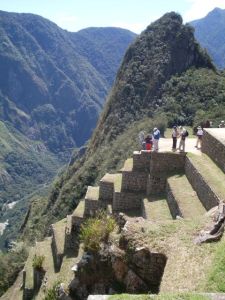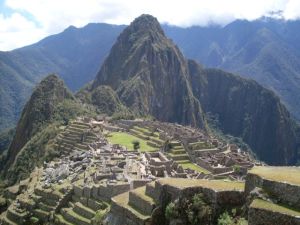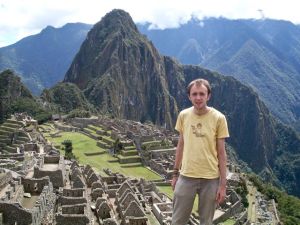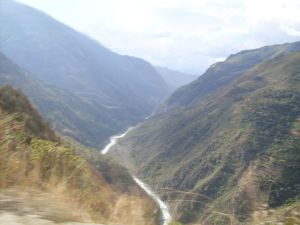Machu Picchu; a splendid sight nestled in a lush section of the Peruvian Andes, one of many examples of the ingenuity of Inca architecture and how it blends spectacularly with the surrounding environment.
This particular example of Inca Architecture is considered by many to be the best way to examine the remarkable history of pre-Colombian civilisation in South America. The Inca empire first emerged around 150 years before the arrival of Europeans in the Americas, the last of a long line of pre-Colombian civilisations that had developed in Peru for 5,000 years.

Many sections of the ruins reflect the surrounding mountains; they are almost always dotted with several people.
Machu Picchu now receives as many as 2,500 visitors a day, showing how immensely popular the site has become, and reflecting its dominance – at least in terms of tourism – over any other pre-Colombian ruin in Peru and the Americas (perhaps only rivaled by Maya ruins in the Yucatan). The massive profitability of such a site has indeed been recognised; travel to Machu Picchu is controlled and regulated by ensuring that it remains difficult to reach, and thus ensuring that travellers have little option but to pay a premium price to get there.
As a result, the only ways of currently getting to the ruins are: by walking the world famous Inca Trail; by means of a train journey from Cusco or the Sacred Valley to the small town of Aguas Calientes (situated in the valley beneath the ruins and built almost exclusively for this purpose); or by walking on one of the alternative trails that have been opened in recent years, namely Lares and Salkantay.
Unfortunately for skint backpackers, even the most economic of these routes is expensive; the train from Ollantaytambo in the Sacred Valley can cost between $60 and $500 return, while the train from Cusco can be even more than that. The Inca Trail costs a minimum of $400 for those who organise to go with guides from Cuzco, while the alternative trails can also reach into hundreds of dollars per person.
Luckily for those who cant fork out even $60 (that buys alot of beer in Peru), there is another way to get to the foot of Machu Picchu: it is possible to walk along the train track from the Hydro Electric Power Plant on the other side of the valley from Aguas Calientes. The aptly named hidroeléctrica de Machu Picchu can be reached from a small town called Santa Teresa, which is on the opposite side of Machu Picchu from Aguas Calientes (see link to map below). The walk from the power plant takes about 2 to 3 hours, plus another 1 and a half hours to climb the steep hill to Machu Picchu.
In August, we went to Machu Picchu by this option following a 2 day jungle boat adventure near Quillabamba. This beautifully situated jungle town is relatively nearby to Santa Teresa, and it meant we didn’t have to travel all the way back to the Sacred Valley just to return again by train. And we were pleased to find it was relatively straightforward to walk, despite this not being the preferred route of the vast majority of those who travel to Machu Picchu, and even less popular amongst those who want to profit from them. Walking along the rails can be a bit hard on the feet without proper boots, and there is a precarious bridge to cross, but it is a nice walk and you can even see the ruins up above on the ridge.
Below is a step by step guide to avoid letting your hard earned cash end up in the hands of those entities who currently have a monopoly over the train routes to Machu Picchu, along with several 5 star hotels in Cusco and Lima, and one right next to the ruins themselves.
—
How to get to Machu Picchu from Cusco via Santa Teresa
1. Go to Cusco and find your way to the “Terminal de carro a Quillabamba” – or the bus terminal for Quillabamba – this is easiest by taxi (3 soles minimum)
2. Take a bus to Santa María, which is on the road between Cusco and Quillabamba, about 4 hours from Cusco. This is a spectacular journey, through Ollantaytambo and then climing past the Nevado Veronica in the Cordilleras Urubamba, all in comfortable transport. Note that this road can sometimes be troublesome during rainy season (15 soles)
3. Take a combi (mini-bus) from Santa María to Santa Teresa, another breathtaking journey (6 soles min.)
4. Stay overnight in Santa Teresa, a pleasant town with some nice restaurants (hostal 10 soles min.)
—
5a. Choose this option to arrive at Machu Picchu at around 10am
i. Get up early (6am) and take a combi to the nearby hydro electric plant (3 soles)
ii. Walk from the Hydro Electric Plant, along the train track, to the entrance at the foot of Machu Picchu
iii. Climb to Machu Picchu to arrive for around 10am.
—
5b. Choose this option to arrive at Machu Picchu at around 5.30am (for those who want to arrive early and climb Huanya Picchu (the mountain in the background)).
i. Spend the morning in Santa Teresa (there are delightful volcanic hot springs)
ii. Take a combi to the Hydro Electric Plant around 3pm (3 soles)
iii. Walk along the train tracks to Aguas Calientes, arrive 5 or 6pm
iv. Stay overnight in Aguas Calientes (20 soles min.)
v. Get up at 4am and climb to Machu Picchu, arrive 5.30am ahead of the first bus load of people.
—
A few more pointers for those who want to do this:
- You should buy your entrance ticket to Machu Picchu beforehand ($20 for students, $40 for Adults), this can be done in either Cusco or in Aguas Calientes after you walk there.
- Aim to walk back to Santa Teresa at about 3 or 4pm, before it gets dark. That should give lots of time to explore the ruins.
- If you walk form the Hydro Plant and climb to Machu Picchu on the same morning (option 5a.), it can be tiring, and will perhaps leave you quite exhausted for exploring the ruins.
- Any of the combi rides can be made by Taxi; if you are traveling with a group this can also be an economical option, costing perhaps a few soles extra per person.
- Believe it or not, a train runs along the train track from the hydro plant as well, but there are only 2 leaving a day; one leaves at 8am in the morning and is reserved for Peruvian nationals only (5 soles), the other leaves about 4 in the afternoon and costs $15 one way, for any nationality. Tickets can be bought from the office in Santa Teresa on the day of travel.
- I would have drawn a map, but Andean Travel Web have already made a very pretty one. This linked page also has more useful information about travel to Machu Picchu via Santa Teresa, while the rest of the Andean Travel Web site has excellent and comprehensive independent travel tips for across Peru.
- All this info is current to August 2009
- Watch out for trains when walking
—
Thats it, I learned the cheapest way to arrive at Machu Picchu, for about 37 soles from Cusco (13 dollars, or even less, one way including the hostal in Santa Teresa). Stingy bastard huh? Well at least my money is in the hands of local transport companies.


